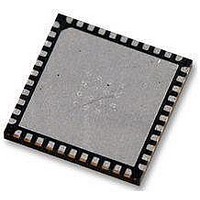AT89LP52-20MU Atmel, AT89LP52-20MU Datasheet - Page 58

AT89LP52-20MU
Manufacturer Part Number
AT89LP52-20MU
Description
IC MCU 8051 8K FLASH SPI 44VQFN
Manufacturer
Atmel
Series
89LPr
Datasheet
1.AT89LP52-20MU.pdf
(113 pages)
Specifications of AT89LP52-20MU
Core Processor
8051
Core Size
8-Bit
Speed
20MHz
Connectivity
EBI/EMI, I²C, SPI, UART/USART
Peripherals
Brown-out Detect/Reset, POR, PWM, WDT
Number Of I /o
36
Program Memory Size
8KB (8K x 8)
Program Memory Type
FLASH
Ram Size
256 x 8
Voltage - Supply (vcc/vdd)
2.4 V ~ 5.5 V
Oscillator Type
Internal
Operating Temperature
-40°C ~ 85°C
Package / Case
44-VFQFN Exposed Pad
Processor Series
AT89x
Core
8051
Data Bus Width
8 bit
Data Ram Size
256 B
Interface Type
Serial
Maximum Clock Frequency
20 MHz
Number Of Programmable I/os
36
Number Of Timers
3
Operating Supply Voltage
2.7 V to 5.5 V
Maximum Operating Temperature
+ 85 C
Mounting Style
SMD/SMT
Lead Free Status / RoHS Status
Lead free / RoHS Compliant
Eeprom Size
-
Data Converters
-
Lead Free Status / Rohs Status
Details
Available stocks
Company
Part Number
Manufacturer
Quantity
Price
Company:
Part Number:
AT89LP52-20MU
Manufacturer:
Atmel
Quantity:
490
14.1
14.2
14.2.1
58
Multiprocessor Communications
Baud Rates
AT89LP51/52 - Preliminary
Using Timer 1 to Generate Baud Rates
Modes 2 and 3 have a special provision for multiprocessor communications. In these modes,
9 data bits are received, followed by a stop bit. The 9th bit goes into RB8. Then comes a stop bit.
The port can be programmed such that when the stop bit is received, the serial port interrupt is
activated only if RB8 = 1. This feature is enabled by setting bit SM2 in SCON.
The following example shows how to use the serial interrupt for multiprocessor communications.
When the master processor must transmit a block of data to one of several slaves, it first sends
out an address byte that identifies the target slave. An address byte differs from a data byte in
that the 9th bit is “1” in an address byte and “0” in a data byte. With SM2 = 1, no slave is
interrupted by a data byte. An address byte, however, interrupts all slaves. Each slave can
examine the received byte and see if it is being addressed. The addressed slave clears its SM2
bit and prepares to receive the data bytes that follows. The slaves that are not addressed set
their SM2 bits and ignore the data bytes.
The SM2 bit can be used to check the validity of the stop bit in Mode 1. In a Mode 1 reception, if
SM2 = 1, the receive interrupt is not activated unless a valid stop bit is received.
The baud rate in Mode 0 depends on the value of the SMOD1 bit in Special Function Register
PCON.7. If SMOD1 = 0 (the value on reset) and TB8 = 0, the baud rate is 1/4 of the system fre-
quency in Fast mode. If SMOD1 = 1 and TB8 = 0, the baud rate is 1/2 of the system frequency,
as shown in the following equation:
:In Compatibility mode the baud rate is 1/6 of the system frequency, scaling to 1/3 when
SMOD1 = 1.
The baud rate in Mode 2 also depends on the value of the SMOD1 bit. If SMOD1 = 0, the baud
rate is 1/32 of the system frequency. If SMOD1 = 1, the baud rate is 1/16 of the system fre-
quency, as shown in the following equation:
Setting TB8 = 1 in Mode 0 enables Timer 1 as the baud rate generator. When Timer 1 is the
baud rate generator for Mode 0, the baud rates are determined by the Timer 1 overflow rate and
the value of SMOD1 according to the following equation:
Mode 0 Baud Rate
Mode 0 Baud Rate
Mode 0 Baud Rate
Mode 2 Baud Rate
TB8 = 1
TB8 = 0
TB8 = 0
=
See “Automatic Address Recognition” on page 60.
2
------------------- -
=
=
=
SMOD1
2
------------------- -
2
------------------- -
2
------------------- -
4
SMOD1
SMOD1
SMOD1
32
4
6
×
(Timer 1 Overflow Rate)
×
×
×
System Frequency
System Frequency
System Frequency
3709B–MICRO–12/10
















